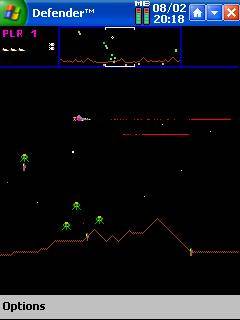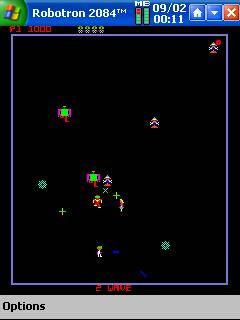|
|
Chris De Herrera's Windows CE Website |
|---|---|
About |
|
| By Chris De Herrera Copyright 1998-2007 All Rights Reserved A member of the Talksites Family of Websites Windows and
Windows CE are trademarks of
Microsoft All Trademarks are owned |
Defender and Robotron
2084 Review
By Allen
Gall, Copyright 2002
Revised 4/16/2002
[an error occurred while processing this directive]
British company Iobox (www.iobox.com;
they make everything from WAP applications to custom ringtones to games
for handhelds) has released remakes of three classic games�Defender,
Robotron 2084, and Marble Madness�for the Pocket PC, with
plans for additional games in the future (Paperboy and Rampage
will be released this summer). Although
fans of these vintage games already have access to these and other games
through the various emulators (PocketNES MameCE, etc.), having a
standalone version has certain advantages.
Since most Pocket PC emulators are ported from desktop emulators,
performance is often spotty, sound reproduction is not entirely accurate,
and game play tends to be less than perfect.
Since the Iobox versions are reproductions (rather than emulators
which use the original ROM code) and are built from the ground up to run
on the Pocket PC, they�re really different from their counterparts.
We�ll take a look at Defender and Robotron, two Midway games, to
see how they stack up.
Defender
Defender is one of the simpler space shoot �em up games. The ever-popular horizontal scroller had you not only blast waves of interesting and maniacal aliens, but also recapture their human hostages and return them safely to the ground. Aliens were numerous and unpredictable, and a radar screen also helped you keep track of what was going on, which was helpful since the game required you to do some prioritizing as you were progressing through the levels.
Iobox�s version of the game does a good job of mimicking the original. I loaded it up and had no trouble at all diving back into the game I knew from all those years ago. Sound and graphics were as close to the original as you would reasonably expect from a handheld device--the aliens had the same jittery, frenetic movement characteristic of the original, and the multicolored, trailing blasts from my ship�s guns looked the same.
|
|
| The aliens are invading, and you�re the only Defender on the planet. |
Reproducing the game play of a coin-op game on a handheld is a bit of a black art; just ask anyone who�s tried to code an emulator for the Pocket PC. In order to pull it off, you�ll need to find just the right mix of game speed and controllability, no small feat considering the differences in processing speeds and button layouts on today�s Pocket PCs.
Although some trade-offs are inevitable, I found the game play of Defender to be enjoyable and reasonably close to the original. Although you�re allowed to remap the keys, I found the default button layout to work just fine. In a game like Defender, you�re not just moving forward all the time; you�ll need to frequently turn around since aliens will approach you from the left and right. I found this somewhat difficult on my iPAQ 3835 thanks to the unusual oblong shape of the directional pad. You�re allowed to use the stylus to control the ship, but I found this method to be much too twitchy to be useful. Speed was just right�neither too fast nor too slow, and I didn�t notice any slowdowns. I did, however, notice an occasional pause, but that may have been related to running the game from an IBM Microdrive.
I found no major flaws with Defender. Although a quick-action game like this is a little hard to
control on current Pocket PCs, I found the game to be playable and nearly
as engrossing as the original. The
next time I get to urge to play Defender, I�ll probably fire up
this version rather than the one in PocketNES.
Robotron 2084
Robotron was one of those unique ideas some people liked and other people hated. A one-dimensional shooter with a top-down perspective, your task was to blast increasingly aggressive hoards of evil robots while protecting humanity�men clad in business suits, women in dresses, and small children. Since it was impossible to accidentally shoot the humans you were charged with saving, Robotron was the sort of game where it was possible to enter a sort of Zen-like state where you achieve a sense of oneness with your pixellated hero while destroying everything in sight.
Visually, Iobox did just as good a job with Robotron as they did with Defender. Everything from the heavily pixellated graphics of the robots to the multicolor transition sequence that takes you from level to level is reproduced accurately. The sound, while generally accurate, did sound occasionally harsh and a little too noisy.
|
|
| They may look silly and walk funny, but the robots in Robotron 2084 are humanity�s worst nightmare. |
Part of what made Robotron unique was the fact that it (like Time Pilot) used two joysticks�one for movement, another for aiming your gun. This fact presents some unique challenges in reproducing the game on a handheld. Iobox handled input in couple of ways, both of which have mixed results. Your character is controlled by using your device�s directional pad, which seems to work well enough. By default, your character simply fires in whatever direction you�re moving (by default, you�re always firing). While this is an easy way of shooting your enemies, it doesn�t allow you to strafe (i.e., fire in one direction while moving in another). Strafing is essential in a game like Robotron, where you�re basically trapped in a box-like screen, and getting cornered by dozens of enemies is par for the course.
Fortunately, the game offers another method of firing. By pressing one of the fire buttons, you can rotate the stream of bullets either clockwise or counterclockwise in one of eight directions. This gives you more control and allows you to strafe, although it doesn�t allow you to quickly jump to a different angle. For example, if you�re firing horizontally to the left and need to fire to the right to blast a robot that�s about to trounce you, you�ll have to cycle through four angles first. This is time-consuming and may cost you a life. Although both firing methods are acceptable within their limitations, it would be interesting to see how the game would work if you were allowed to control movement with the stylus and have access to the various firing angles with the directional pad. Nevertheless, the game is still fun and manages to have most of the charm of the original.
The Bottom Line
Although not perfect, Robotron and Defender are solid reproductions of the original games and bode well for future offerings from Iobox. Designed to run on Pocket PCs running MIPS and ARM processors, both games caused a bit of a backlash when they entered the market at a price of $19.99 per game. Many gamers have complained that�s a bit too much for what are essentially 20 year-old games. However, keep in mind that some of the game�s features (difficulty settings, persistent high scores uploadable to the Internet via SMS, stylus input) are not available in many emulators. While purists may not want to bother with a reproduction that doesn�t use original code, casual gamers who don�t want to devote time to downloading and tweaking emulators, tracking down ROM files, and putting up with sound, graphics, and performance issues would do well to consider the offerings from Iobox. That being said, I agree that Iobox would likely sell more copies of these games if the price were to be lowered a bit. As more games are released, I wouldn�t be surprised to see a discounted bundle offering several games for one price. As long as Iobox chooses the best games and does a good job of reproducing them, the demand for these games will always be there.
Defender and Robotron 2084 support Pocket PCs running MIPS and ARM CPUs (Casio EM-500, E-115, E-125, and all Pocket PC 2002 devices) and are available at Pocketgear.com for $19.99. Rampage and Paperboy will be released sometime this summer.
Allen Gall is a freelance game reviewer and the games editor for Pocket PC FAQ. If you have a game you'd like Allen to review, you can e-mail him at allen@Pocket PC FAQ
[an error occurred while processing this directive]




